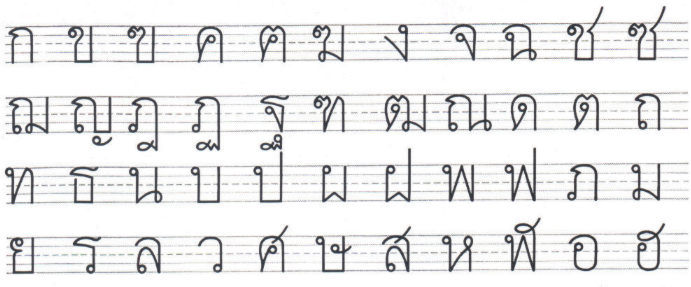![]() LANGUAGE
LANGUAGE
![]()

The official national language, spoken by almost 100 per cent of the population is, THAI, classified by linguists as belonging to a Chinese-Thai branch of the Sino-Tibetan family. It is a tonal language, uninflected, and predominantly monosyllabic. Most polysyllabic words in the vocabulary have been borrowed, mainly from Khmer, Pali or Sanskrit. Dialects are spoken in rural areas. Principal other languages are Chinese and Malay. English, a mandatory subject in public schools, is widely spoken and understood, particularly in Bangkok and other major cities.
The Thai language is liberally sprinkled with words from Pali and Sanskrit (the classical languages, respectively, of Theravada Buddhism and Indian Hinduism). Written Thai employs an alphabet of 44 consonants and 32 vowels that combine to form syllabic sounds.
Thai is a tonal monosyllabic language. The same word can be said in five different ways - normal or middle tone, high, low, rising and falling.
In Thai the meaning of single syllable may be alter in five different tones.
Thai is one of the oldest languages in East and South-East Asia. According to linguist, it may event pre-date Chinese, at least in its
prototypical form. Many of the so-called "loan-words" thought to be borrowed from Chinese by the Thais actually have an
Austro-Thai origin. At any rate, Chinese and Thai have many similarities, since both are
monosyllabic tonal languages.
King Ramkhamhaeng the Great who ruled the Sukhothai Kingdom from 1279-1298 initiated the Thai inscription in 1292. The
inscription is considered to be a seminal source of Sukhothai history as well as a masterpiece of Thai literature.
Like English, it is read from left to right, but that is where the similarities end. Some English sounds like
"th", "v" and "z" do not appear at all, while some Thai sounds are not commonly used in English either. Further, it should be noted that in transcribing Thai sounds into English phonetics some consonants (e.g., b, p, l, n, d, and t) can be used interchangeably.
There are no plurals in Thai, nor are there tenses as such. A word or two is usually added to determine the past, present or
future.
In Thailand's major cities, the level of English can be quite good, but visitors will find that the Thais' ability to speak English diminishes as one moves further away from the population centers.
Conservative and courteous social behavior and dress are highly valued by the Thais. The Thai pronouns for "I" are different for male and female speakers. Men will use
'phom' and women 'dee-chan' in formal settings. However, it is common to drop these formal pronouns in face-to-face conversations or to use kin terms (e.g., elder/younger sibling ; aunt uncle) or first names instead.
Men will also show deference by ending their questions and statements with 'khrap', a "polite particle" to show respect and
refinement. Women end their questions and statements with 'kha'. In greeting, the Thais normally
"wai" rather than shake hands. To make the "wai," place your hands together, bringing them up just under the nose and bow the head slightly. Because it is a sign of respect as well, the younger person initiates the gesture, but not the reverse.
The Thais consider the head to be sacred and the feet profane. Touching someone's head, other than a child's, is taboo. A younger person or someone of lower social status will even lower their head in passing by a senior. In sitting too, especially in the presence of monks or other exalted persons, attention must be paid to head level. Even more caution must be taken with the feet because of their contact with dirt. Similarly, the left hand is "polluted" in ritual meaning.
In entering hallowed spaces such as temples, classrooms, even someone's home, shoes are removed. (For your own convenience, loafers are best.) In rural settings, where it is common to walk barefoot, the feet are bathed at the entrance to the house. In offering food to monks during their morning rounds, the offering laity remove footwear as a sign of respect. Women will also avoid touching a monk in making an offering. On occasions where gifts are given or received, the gift, tastefully wrapped, is always presented and received with the right hand only. The left hand is ritually cupped below the right elbow and the head bowed slightly in respect. The act may be completed with a "wai" also. Feet should never be used to shove an object on the floor to someone. In sitting, care must be taken to avoid pointing the feet, even unintentionally, at someone else. In sitting on the floor, men can sit cross-legged; women "tuck" their legs to the side. In festive occasions, women and men tend to congregate and converse with members of their own gender.
To learn THAI interactively on the web, click here.
Copyright © 2000 - 2002 HelloSiam.com All rights reserved.